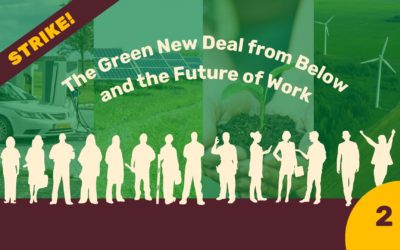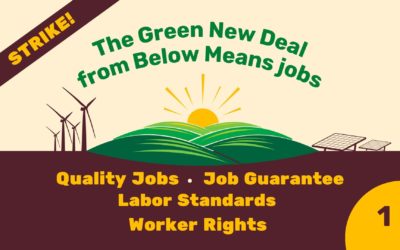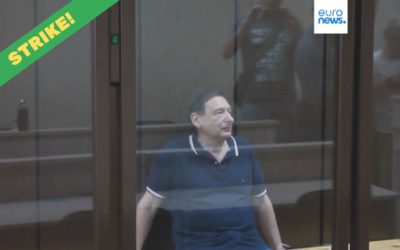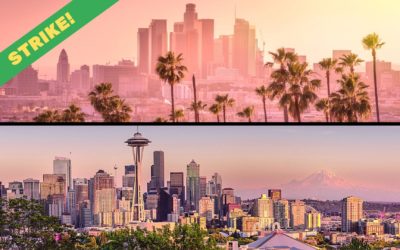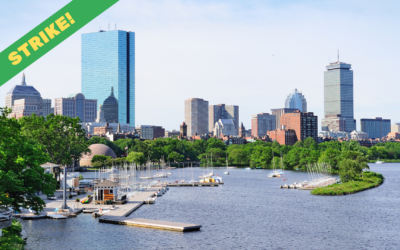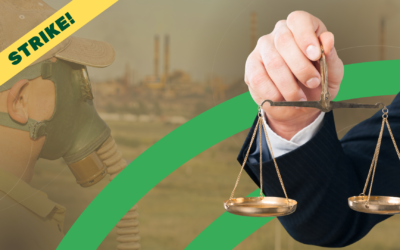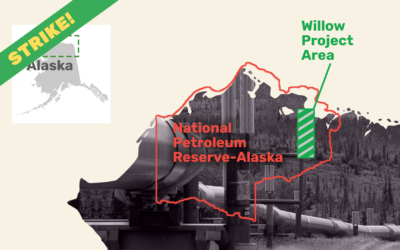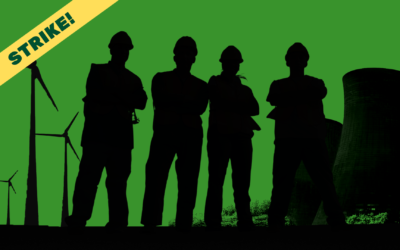
Just Transition for Auto Workers: The Answer to Auto’s Race to the Bottom
The strike by the UAW against the Big Three auto companies has brought together autoworkers and climate advocates around the demand for a just transition to a climate-safe auto industry. But why is a just transition necessary, and how could a just transition for auto workers be achieved?
The Green New Deal from Below and the Future of Work
While protecting the climate will require millions of jobs, there is no guarantee that those jobs will be good jobs. The local and state Green New Deals that have sprung up around the country are not only creating new jobs, they are also addressing low wages, lack of opportunities for training and advancement, de facto exclusion from access to good jobs, and other dimensions of job quality. They are making it easier for workers to organize. And some of them are moving toward providing a “jobs guarantee.” Taken together, these initiatives are laying the foundations for a transformation of the world of work.
The Green New Deal from Below Means Jobs
Despite opposition to a national Green New Deal by rightwing politicians and the fossil fuel industry, many “Little Green New Deals” are under way at the local and state level – and they are already expanding the number and improving the quality of jobs. This Commentary starts with the youth jobs corps that have developed in Green New Deal cities and others with climate protection programs. It reviews the jobs that are already being created by state and local Green New Deal from Below programs and evaluates how many could be created by a fully developed Green New Deal. The next Commentary will examine how the Green New Deal from Below is making green jobs be good jobs.
Free Boris Kagarlitsky!
Russian scholar and activist Boris Kagarlitsky has been jailed for a blog post on the Russia-Ukraine war. His recent writings range from a Ukraine peace plan to climate movement strategy. An international campaign is demanding his release from prison.
Green New Deal in the Cities – Part 2: Need and Opportunity
While the Green New Deal has been largely blocked at the national level, it is thriving in communities, states, and cities. The previous Commentary, “The Green New Deal in the Cities – Part 1,” examined in depth Boston’s Green New Deal. This Commentary examines the Los Angeles and Seattle Green New Deals in the context of urban policy for climate justice.
The Green New Deal in the Cities – Part 1: Boston
While the Green New Deal started as a proposed national program, some of the most impressive implementations of its principles and policies are occurring at a municipal level. Part 1 of “The Green New Deal in the Cities” provides an extended account of the Boston Green New Deal, perhaps the most comprehensive effort so far to apply Green New Deal principles in a major city. Part 2 presents Green New Deal-style programs developing in Los Angeles and Seattle, and reviews the programs and policies being adapted in cities around the country to use climate protection as a vehicle for creating jobs and challenging injustice.
Protecting Workers and Communities – From Below Part 2: There Ought to Be a Law
As key states start reducing their use of coal, oil, and gas, what will happen to the workers who produce, transport, and burn those fossil fuels? The previous Commentary, “Protecting Workers and Communities – From Below: Part 1: On the Ground” described local programs to protect workers and communities from side effects of power plant closings and other climate protection measures. This Commentary portrays state-level programs to guard workers and communities against loss of livelihoods and income from climate protection policies.
The Willow Project: Which Side Should Labor Be On?
American unions increasingly recognize the threat of climate change to workers and their communities. Yet some unions continue to promote programs like Alaska’s Willow Project that violate the basic requirement of climate safety: that fossil fuel extraction and burning must be subject to a rapid, managed decline. Fortunately, they are not the only voices in the labor movement.
Protecting Workers and Communities–From Below | Part 1: On the Ground
Climate protection will create jobs for workers and economic development for communities. But as fossil fuel facilities are closed down there will also be some jobs lost and some communities will lose taxes and other economic benefits. This Commentary recounts what communities around the country are doing “on the ground” to protect workers and local economies from collateral damage from the transition to climate-safe energy.

